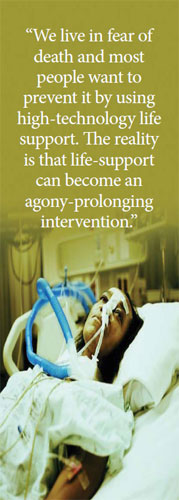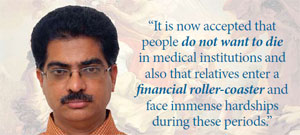 |
 |
 |
|
August 2009
|
Death-denying acts: Can we afford the cost of prolonging a life that’s gone?By Dr Hariharan Seetharaman
However, because that cost is borne by the State, users of the public healthcare system rely on intensive care unit (ICU) services under circumstances when they might not if they paid directly for it. It raises several dilemmas for institutions, hospital patients and their families, because technology has made possible many recoveries that would once have been miraculous, but still cannot hold the inevitable at bay forever. In modern times, all branches of medicine have grown rapidly. Intensive care medicine has developed beyond anybody’s imagination, with high-technology support for every failing organ system of the human body. People have started thinking that death is preventable with the help of technology. Because of this “death-denying” notion of society, ICU admissions have increased, and dying on a ventilator has become common in many countries. A few years ago, Time magazine reported that while 70% of Americans wanted to die at home, 75% died in hospitals and at least 30% died in the ICU. Similarly, in Canada, a survey showed that approximately 70% of the population died in hospitals and 50% of deaths occurred in the ICU. It is now accepted that people do not want to die in medical institutions and also that relatives enter a financial roller-coaster and face immense hardships during these periods. Widespread misconceptions about the value of cardiopulmonary resuscitation (CPR ) are especially hyped by television. In other words, death has become more of a process rather than an event. The ethical dimensions of end-of-life care are profound. We live in fear of death and most people want to prevent it by using high-technology life support. The reality is that life-support can become an agony-prolonging intervention. When the process of death gets prolonged in a “futile” patient, intensive care is merely toying with biological parameters. Vitalism, the belief that life processes are not wholly governed by the laws of physics and chemistry, may favour an argument that anything should be done to “save” life, but delaying death by high-technology intervention will not necessarily achieve the desired quality of life. Some argue that modern medicine has to hold on to human life because it is considered “worthy” (worthiness morality); however, the reality is that this is usually done on the basis of affordability. Generally in high-technology medicine, huge sums of money are spent to treat a relatively small number of patients. Many treatment modalities of high-technology medicine are limited to only those patients who have access to it because of wealth, location, social class, etc. Inequality of access to healthcare is a worldwide phenomenon and greatly depends on the global inequalities of resource distribution—the richest 1% of the world’s population earns as much as the poorest 57%. The per capita healthcare expenditure for the 960 million people living in the world’s high-income countries is US$2,736. This is 130 times that of the per capita expenditure for the 2.5 billion people living in the low-income countries, which is a meagre US$21. The average cost of one high-technology medical intervention in the developed world is much higher than the annual per capita health expenditure in many developing countries. In the English-speaking Caribbean, high-technology interventions such as ICU care are usually free to citizens, and are in constant demand. There is a clear need for allocating these services to those who would really benefit from them. Determining whether it is worthwhile is the heart of the dilemma. The capability of high-technology to alter the dying process and prolong a low-quality life has been described as the Eos Syndrome of modern medicine. In Homer’s mythology, the goddess Eos asks Zeus to grant immortality to her mortal lover, Tithonos; forgetting to ask for his eternal youth. Tithonos grows so old that Eos abandons him in isolation forever. To some, this is similar to managing a patient on life-support systems in an ICU, prolonging the process of death. Disease has to be addressed at a primary level, without having to deal with the agonies of end-of-life care. Another major ethical problem is the “rationing” of intensive care. This is quite germane to Trinidad and Tobago where there is a shortage of ICU beds. Although it is unanimous that cost should not influence decisions, in practice, things are quite different. An interesting phenomenon occurred when the Eric Williams Medical Sciences Complex changed from a “feefor- service” to an “all free” system in January 2006. During the fee-for-service days, an 80-year-old man with incurable brain haemorrhage was admitted to the ICU and was put on life-support systems. His relatives asked to end the life support due to the financial strain. Nowadays, when there is no apparent knowledge of the costs involved, many relatives want to continue support until the inevitable happens. Even a discussion about the end-of-life care is misinterpreted as pulling the plug. Medical care might be better directed towards preventing illness and treating the curably ill, rather than supporting the life of an incurably sick patient. Our public should not be carried away by television shows telecasting miraculous survivals following CPR and ICU admissions. Death is the stark end of everyone’s life. The unnecessary delay is quite distressing not only to the patient, but also to the dear and near ones, as well as healthcare workers.
|

 Although we no longer pay directly, people should be aware that the cost of treatment at an intensive care unit in Trinidad and Tobago is between $5,000-$20,000 a day. This enormous cost can be a strain on any healthcare system, especially when there is a perennial shortage of hospital beds.
Although we no longer pay directly, people should be aware that the cost of treatment at an intensive care unit in Trinidad and Tobago is between $5,000-$20,000 a day. This enormous cost can be a strain on any healthcare system, especially when there is a perennial shortage of hospital beds.